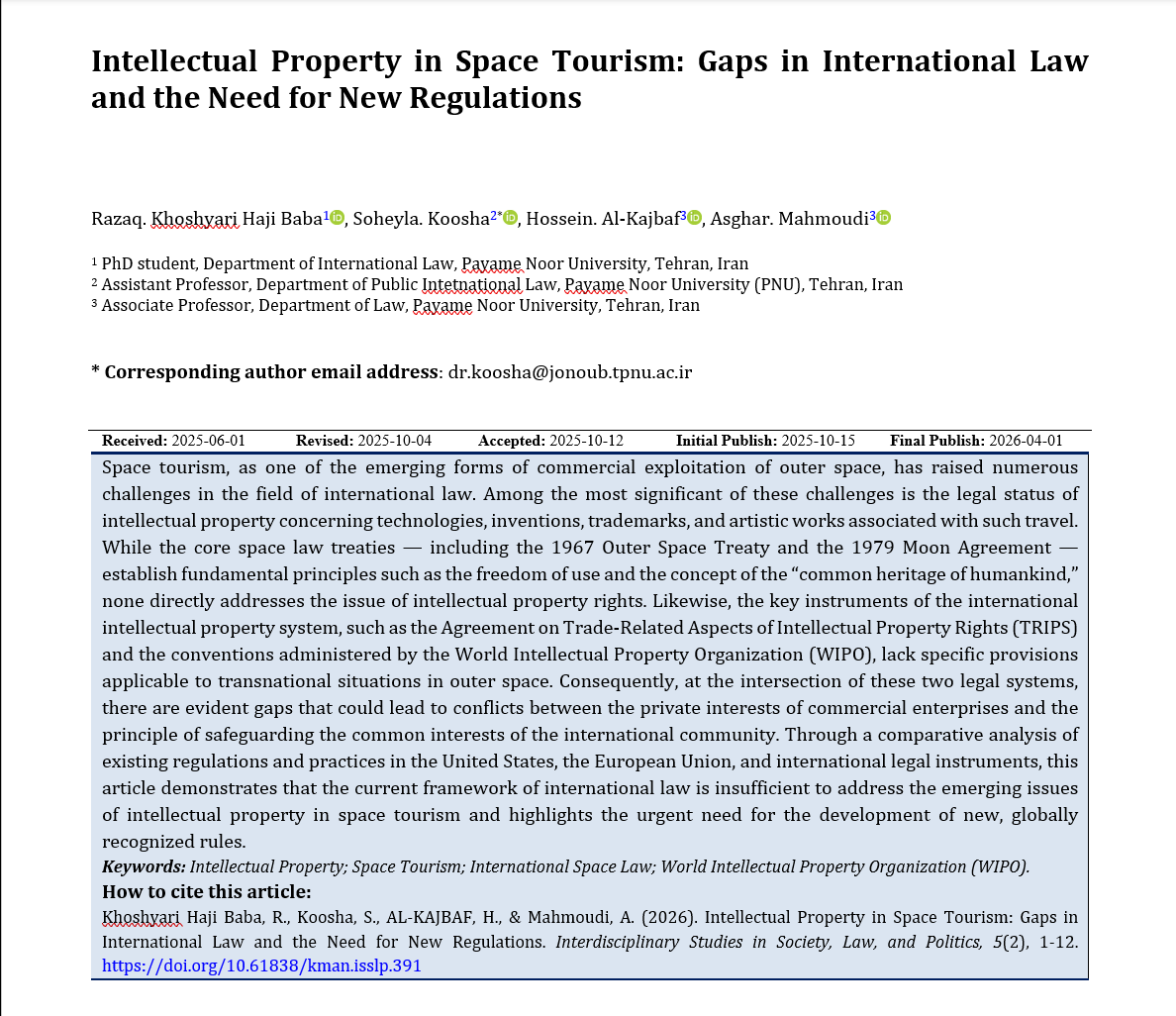Intellectual Property in Space Tourism: Gaps in International Law and the Need for New Regulations
Keywords:
Intellectual Property, Space Tourism, International Space Law, World Intellectual Property Organization (WIPO)Abstract
Space tourism, as one of the emerging forms of commercial exploitation of outer space, has raised numerous challenges in the field of international law. Among the most significant of these challenges is the legal status of intellectual property concerning technologies, inventions, trademarks, and artistic works associated with such travel. While the core space law treaties — including the 1967 Outer Space Treaty and the 1979 Moon Agreement — establish fundamental principles such as the freedom of use and the concept of the “common heritage of humankind,” none directly addresses the issue of intellectual property rights. Likewise, the key instruments of the international intellectual property system, such as the Agreement on Trade-Related Aspects of Intellectual Property Rights (TRIPS) and the conventions administered by the World Intellectual Property Organization (WIPO), lack specific provisions applicable to transnational situations in outer space. Consequently, at the intersection of these two legal systems, there are evident gaps that could lead to conflicts between the private interests of commercial enterprises and the principle of safeguarding the common interests of the international community. Through a comparative analysis of existing regulations and practices in the United States, the European Union, and international legal instruments, this article demonstrates that the current framework of international law is insufficient to address the emerging issues of intellectual property in space tourism and highlights the urgent need for the development of new, globally recognized rules.
Downloads
References
Benkö, M., & Schrogl, K. U. (2006). Space law: Current problems and perspectives for future regulation. Carl Heymanns.
Bently, L., & Sherman, B. (2014). Intellectual Property Law. Oxford University Press.
Christol, C. Q. (1980). The Moon Treaty: Fact and Fiction. Journal of Space Law, 8(2), 345-368.
Correa, C. M. (2007). Trade-related aspects of intellectual property rights: A commentary on the TRIPS Agreement. Oxford University Press. https://doi.org/10.1093/law/9780199271283.001.0001
Drahos, P. (2016a). Intellectual property, technology transfer and development. Edward Elgar.
Drahos, P. (2016b). Intellectual Property, Trade and Development: Strategies to Optimize Economic Development in a TRIPS-Plus Era. Edward Elgar.
European Space Policy, I. (2017). European Space Policy: Innovation, Regulation, and Governance. ESPI.
Franssen, V. (2021). Intellectual property and cultural production in outer space. Air and Space Law, 46(1), 85-104.
Gabrynowicz, J. I. (2010). The 50th Anniversary of the Outer Space Treaty. Mississippi Law Journal, 78(2), 431-442.
Gervais, D. J. (2021). The TRIPS Agreement: Drafting history and analysis. Sweet & Maxwell.
Ghaffarian Keblou, M., Pashazadeh, H., Rahbar Farsha Pira, N., & Masoudi, N. (2022). International Requirements of Intellectual Property in International Community and Its Application in the Laws of Iran and the United States. International Studies Journal (ISJ), 19(3), 271-286.
Ginsburg, J. C. (2018). International Copyright Law and Policy. Oxford University Press. https://doi.org/10.1093/oxfordhb/9780198758457.013.23
Habiba, S., Kazemi, H., & Sadeghi, M. (2023). Intellectual Property Rights and Technology Transfer in the Space Industry. Space Science and Technology, 15(1), 107-119. https://doi.org/10.30699/jsst.2022.1331
Harrison, J. (2020). Intellectual Property Challenges in the Commercial Space Industry. Air and Space Law, 45(2), 205-225.
Hobe, S. (2013). The Current and Future Perspective of Space Law. Zeitschrift für Luft- und Weltraumrecht, 62(2), 119-135.
Hobe, S. (2020). Space Law and International Commercial Arbitration: Conflicts and Resolutions. Springer.
Hugenholtz, P. B. (2016). Copyright and the Digital Space: Challenges Beyond Earth. Journal of Intellectual Property Law & Practice, 11(3), 201-215.
Jakhu, R., & Pelton, J. (2017). Global Space Governance: An International Study. Springer. https://doi.org/10.1007/978-3-319-54364-2
Jasentuliyana, N. (1992). Perspectives on International Space Law. Kluwer Law International.
Johnson, S. (2019). Commercial space exploration: Law and policy. Oxford University Press.
Koosha, S. (2024). Protecting the intellectual property rights of tourists and advancing space tourists industry. Journal of Law and Political Studies, 4(1), 84-97.
Kur, A., & Drexl, J. (2018). Intellectual Property and General Legal Principles: Is IP a Lex Specialis? Edward Elgar.
Lyall, F., & Larsen, P. B. (2018). Space Law: A Treatise. Ashgate. https://doi.org/10.4324/9781315610139
Masson-Zwaan, T., & Freeland, S. (2010). Introduction to Space Law. Kluwer Law International.
Mirkarimi, P., Mirabbasi, S. B., & Moradi, M. (2013). Investigating the role and status of intellectual property rights in the system of public international law. Iranian Monthly of Political Sociology, 5(11), 3368-3384.
Nasa. (2015). Commercial Space Launch Competitiveness Act (Space Act 2015): Overview and Implications. Washington, DC: NASA Office of Legislative Affairs.
Reinbothe, J., & Lewinski, S. v. (2015). The WIPO Treaties on Copyright: A Commentary on the WCT, the WPPT, and the BTAP. Oxford University Press.
Ricketson, S., & Ginsburg, J. C. (2006). International Copyright and Neighbouring Rights: The Berne Convention and Beyond. Oxford University Press.
Soleimani, H. (2008). Intellectual property international system of protection of rights Bglass. Public Law Researsh, 11(26), 243-261.
Tronchetti, F. (2015). Intellectual Property Rights in Outer Space Activities: Emerging Challenges. Journal of Space Law, 41(2), 307-325.
von der Dunk, F. G. (2015a). Intellectual Property in Space Activities: New Challenges. In F. G. v. d. Dunk & F. Tronchetti (Eds.), Handbook of Space Law (pp. 233-255). Edward Elgar. https://doi.org/10.4337/9781781000366
von der Dunk, F. G. (2015b). The Registration Convention. In F. G. v. d. Dunk & F. Tronchetti (Eds.), Handbook of Space Law (pp. 209-230). Edward Elgar. https://doi.org/10.4337/9781781000366
von der Dunk, F. G. (2015c). Space tourism, private spaceflight and the law. Zeitschrift für Luft- und Weltraumrecht, 64(2), 113-128.
von der Dunk, F. G., & Tronchetti, F. (2016). Arbitration in Outer Space: Legal Challenges and Practical Solutions. Air and Space Law, 41(3), 171-189.
Williamson, M. (2016). Ownership and Property Rights in Space Resources: US Perspectives. Journal of Space Law, 41(1), 45-62.
Wipo. (2019). Intellectual Property Challenges in Outer Space Activities: Report of the Committee on Development and Intellectual Property. Geneva: WIPO Publications.

Downloads
Additional Files
Published
Submitted
Revised
Accepted
Issue
Section
License
Copyright (c) 2025 Razaq Khoshyari Haji Baba, Soheyla Koosha, HOSSEIN AL-KAJBAF, Asghar Mahmoudi (Author)

This work is licensed under a Creative Commons Attribution-NonCommercial 4.0 International License.





